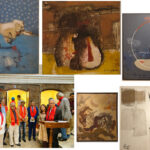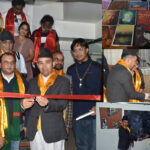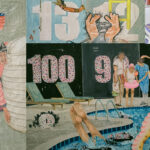Artists from around the globe share common ground. Regardless of their location or background, they exhibit similarities in their creative processes. Over time, the brilliance of their chosen colors and subjects emerges, elevating their work to new heights. One such exceptional art exhibition is currently underway at the Siddhartha Art Gallery, featuring senior artists from Bangladesh and Nepal. Running from May 7th to May 10th, this showcase highlights the rich diversity of artistic expression.
During the exhibition’s opening, Bangladesh’s Ambassador to Nepal, Mr. Salahuddin Noman Chaudhary, expressed confidence that this event would further strengthen bilateral ties and foster friendship between the two countries. Additionally, artists from India and Nepal participated in a workshop held at the embassy premises, providing an opportunity to share insights into their lives and artistic endeavors.

Similarly, Sangita Thapa, the founder director of the Siddhartha Art Gallery, emphasized that the connection between Bangladesh and Nepal transcends mere diplomatic ties—it is deeply rooted in art, which knows no boundaries. This exhibition serves as a reaffirmation that artists must surpass the rigid borders of the post-colonial era to reignite the age-old bonds among the people of South Asia.
Professor Mohammad Yunus, Chairman of the Art Bangla Foundation in Dhaka, remarked that the exhibition seeks to spotlight the rich artistic heritage of both nations by celebrating their profound values and fostering mutual understanding.
Rafiqun Nabi, a prominent artist from Bangladesh, has contributed three paintings from his latest collection. His artwork is distinguished by bold lines, with drawings serving as the primary element to create stylistic forms, colors, and spaces.

Kiran Manandhar, a distinguished artist from Nepal, reveals that he never premeditates his paintings; instead, they evolve organically, mirroring the flow of his life. He transforms his imaginations and emotions into abstract forms, expressing primarily his joy, sorrow, and his stance on societal matters. His creations resonate with impressions of nature, tranquility, truth, love, beauty, and peace.
Monirul Islam, a renowned artist from Bangladesh, endeavors to achieve a nuanced equilibrium by intertwining space, lines, textures, and forms into a rich tapestry of expression. Describing his paintings, he portrays them as a distinctive fusion of delicate doodles, lyrical lines, and vibrant colors, each narrating a tale of human emotions and experiences. His artworks exude a subtle gray hue, intricately woven within the paintings themselves.

Shashi Bikram Shah, a seasoned artist from Nepal, showcases his distinctive style in the exhibition, featuring horses depicted in various emotions. These horses symbolize the chariot pullers of the sun god. According to Shah, the seven horses are named Gyatri, Ushnik, Anushtub, Brihati, Pagti, Trishtubh, and Jagati, each representing one of the seven colors of the rainbow. He expresses the emotions of these horses in the majority of his paintings.
Muniruzzaman Munir, hailing from Bangladesh, portrays the distinctive ecosystem of abundant flora and fauna in his paintings. The artist expresses his enduring fascination with the mystical beauty of the Sundarbans, captivated by the aura of nature and the ethereal subconscious emotions evoked by its ambiance.

Vijay Thapa, another esteemed senior artist from Nepal, is known for his distinctive painting style and use of colors. He asserts that his artwork goes beyond showcasing individual aesthetic prowess; rather, it embodies the entire culture and stage of civilization that a country or region is experiencing.
Kanak Chanpa Chakma finds faith in color, symbolizing hope. Her palette mirrors the vibrant tapestry of her culture, drawing from the rich hues found in temples and secret rituals. Chakma explains that she manipulates color to capture the natural cadence and the rolling contours of the hills, infusing her art with a sense of tranquility and vigor.
Krishna Manandhar, one of Nepal’s most senior artists, expresses his lifelong attraction to nature, aiming to encapsulate its essence in his paintings. He meticulously builds layers upon layers to craft imagery that resonates deeply with the natural world.

Mohammad Iqbal, representing Bangladesh, portrays vulnerable and suffering children as a critique of what is often hailed as modern civilization. The pain, insecurity, and fear manifest vividly in the eyes and expressions of these children. His paintings often depict children who are mentally scarred by war and conflict, the adverse effects of environmental pollution, and the exploitation of child labor and slavery.
The artworks displayed at the gallery are truly unique, crafted by esteemed senior artists from Nepal and Bangladesh. For art enthusiasts, this exhibition is a must-visit, offering a rare opportunity for meaningful interactions with these celebrated artists during the exhibition.







Leave A Comment